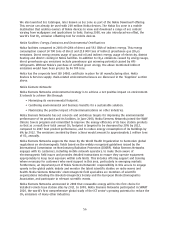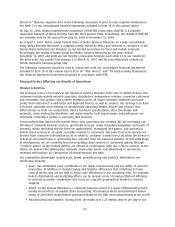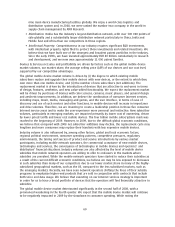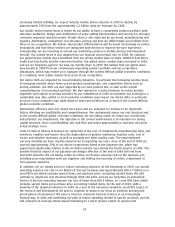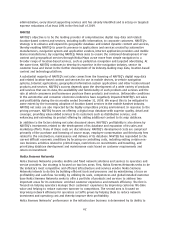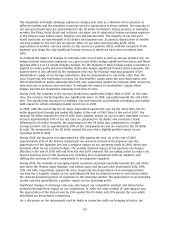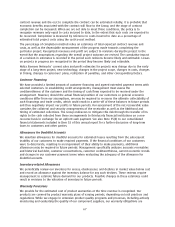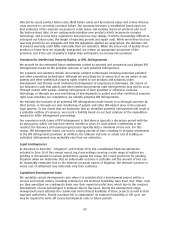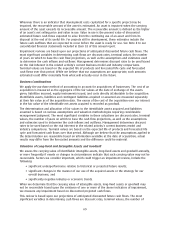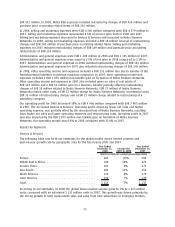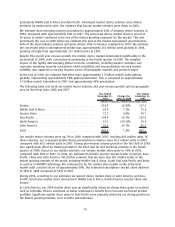Nokia 2008 Annual Report Download - page 66
Download and view the complete annual report
Please find page 66 of the 2008 Nokia annual report below. You can navigate through the pages in the report by either clicking on the pages listed below, or by using the keyword search tool below to find specific information within the annual report.Note 35 to our consolidated financial statements included in Item 18 of this annual report. See also
Item 11. “Quantitative and Qualitative Disclosures About Market Risk” and Item 3D. “Risk Factors.”
Seasonality
Our mobile device sales are somewhat affected by seasonality. Historically, the first quarter of the
year was the lowest quarter of the year. The second quarter was up from the first quarter and the
third was also up from the second quarter. The fourth quarter was the strongest quarter, mainly due
to the effect of fourth quarter holiday sales. Despite the pronounced weakening of the global mobile
device market in the fourth quarter of 2008, we still continue to see the fourth quarter as our
strongest quarter in volumes. However, over time we have seen a trend towards less seasonality. The
difference between the sequential holiday seasonal increase in the Western hemisphere in fourth
quarter and subsequent decrease in first quarter sequential volumes has moderated. The moderation
in seasonality has been caused by shifts in the regional makeup of the overall market. Specifically,
there has been a larger mix of industry volumes coming from markets where the fourth quarter
holiday seasonality is much less prevalent.
Currently, services net sales are primarily derived from “combos” where certain devices are offered in
combination with one or more services. Accordingly, our services net sales are affected by the same
seasonality as mobile device sales.
NAVTEQ’s sales to the automotive industry are not significantly impacted by seasonality. However,
NAVTEQ’s sales to navigation device and mobile handset manufacturers typically see strong fourth
quarter seasonality due to holiday sales. As the relative share of licensing of NAVTEQ’s digital map
data and related locationbased content and services for use in mobile devices compared to invehicle
navigation systems has increased during the last few years, NAVTEQ’s sales have been increasingly
affected by the same seasonality as mobile device sales.
Our network infrastructure business has also experienced some seasonality during the last few years.
Its sales have been higher in the last quarter of the year compared with the first quarter of the
following year due to network operators’ planning, budgeting and spending cycle.
Accounting Developments
The International Accounting Standards Board, or IASB, has and will continue to critically examine
current International Financial Reporting Standards, or IFRS, with a view towards increasing
international harmonization of accounting rules. This process of amendment and convergence of
worldwide accounting rules continued in 2008 resulting in amendments to the existing rules effective
from January 1, 2009 and additional amendments effective the following year. These are discussed in
more detail under “New accounting pronouncements under IFRS” in Note 1 to our consolidated
financial statements included in Item 18 of this annual report. There were no IFRS accounting
developments adopted in 2008 that have a material impact on our results of operations or financial
position.
Subsequent Events
In February 2009, we issued EUR 1 750 million of Eurobonds with maturities of five and ten years
under our EUR 3 000 million Euro Medium Term Note, or EMTN program, to repay part of our existing
shortterm borrowings. We voluntarily cancelled our USD 2 000 million committed credit facility
maturing in 2009 due to this repayment. In February, we also signed and fully drew down a
EUR 500 million loan from the European Investment Bank. The proceeds of the loan will be used to
finance part of our smartphone research and development expenses.
Critical Accounting Policies
Our accounting policies affecting our financial condition and results of operations are more fully
described in Note 1 to our consolidated financial statements included in Item 18 of this annual
65



